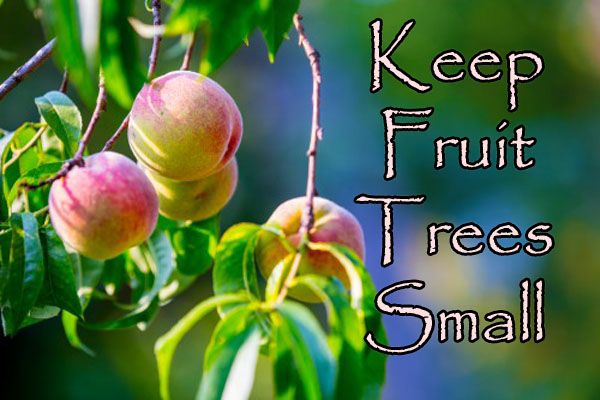Fruit trees provide abundant harvests of delicious homegrown produce, but many standard varieties can grow quite large, taking up considerable garden space. Fortunately, with proper pruning techniques, it’s possible to manage the size of fruit trees and keep them under control even in small yard settings.
This article covers simple methods for keeping both newly planted and established fruit trees compact through pruning. With a little regular care, you can maintain fruit trees at whatever height is most convenient for easy picking and care.
Why Keep Fruit Trees Small?
There are several advantages to intentionally limiting the size of fruit trees
- Easy harvesting – Fruit on compact trees is within arm’s reach so picking is simple. No ladders needed!
- Good light exposure – Smaller trees allow more sunlight to penetrate for ripening fruit
- Higher yields – Less shading and better light exposure result in more abundant harvests.
- Pest management – Compact growth makes monitoring and controlling pests much simpler.
- Earlier bearing – Young dwarf trees start fruiting 1-2 years sooner than full standards.
- Space efficiency – Small trees maximize variety and production in tight spaces like small yards,
How to Limit Fruit Tree Size Through Pruning
The key to controlling fruit tree size lies in pruning. Follow these basic steps:
At Planting Time
- Start with a young whip about 1⁄2-3⁄4 inch thick.
- Cut the whip back by 2/3 its height, leaving just 1/3 of top growth. Aim for 18-24 inches tall.
- Choose a strong outward facing bud for the first scaffold branch.
First Spring
- In early spring, select your lowest scaffold branch from the buds that sprout.
- Pinch off other buds to leave just one shoot per node.
Early Summer
- In June, prune new shoots back by at least half their length to stunt growth.
- Remove inward growing shoots and overly vertical branches.
Following Winters
- Open up center by removing inward and vertical wood.
- Head branches back to just above fat buds to limit extending growth.
Pruning Mature Fruit Trees to Reduce Size
You can also prune established, overgrown fruit trees back to a smaller size:
- Identify several well-spaced scaffold branches to retain as the main structure.
- Cut off all other branches, leaving just the key scaffolds.
- Head the scaffold branches back by 1/3 to 1/2 their length.
- New shoots will emerge closer to the trunk – keep those you want for regrowth.
- Maintain the compact shape with regular summer pruning.
Techniques for Specific Fruit Tree Types
Certain pruning approaches work especially well to control size in particular fruit trees:
Apples and Pears
- Start by cutting spring whips back to 18-24 inches at planting.
- In summer, tip back shoot growth by half and thin crowded branches.
- Head main branches in winter to control height and develop fruit spurs.
Peaches/Nectarines
- Cut spring whips back to just above a side shoot to force low branching.
- Prune established trees to open centers to improve light exposure and fruit quality.
- Remove excessive vertical shoots in summer to maintain compact shape.
Cherries
- At planting, head whip just above a bud 18-24 inches up to force low branching.
- Establish scaffolds in first year, and tip back shoots by half in summer.
- Keep mature tree open and minimize height with summer tip pruning.
Plums
- Cut plum whips back by at least half when planting to encourage branching low on the trunk.
-Remove strong vertical shoots in summer to encourage spreading growth habit.
- Prune established trees in winter to open shape and improve light penetration.
Apricots
- Prune first year whips back to 20-24 inches above ground to force low scaffolds.
- Remove all but 3-4 well-spaced branches as the basic framework.
- Head branches by at least half their new growth in early summer to slow growth.
Maintaining Small Fruit Trees Long Term
Here are some tips for keeping compact fruit trees at a controlled size long term:
- Prune every year – regular pruning is key to restricting size.
- Be more aggressive – don’t be afraid to remove a lot of excess growth.
- Get pruning done at the right times – especially summer tipping.
- Use heading cuts to remove vertical shoots and discourage upward growth.
- Think open shape – improve light and air penetration by thinning interior branches.
- Remove suckers – prune out vigorous shoots from the base and rootstock.
- Stay on top of it – frequent light pruning is more effective than infrequent heavy pruning.
Enjoying Productive Dwarf Fruit Trees
With a commitment to regular pruning and training, it’s possible to grow a wide variety of fruit trees in compact form. The rewards are plentiful fruit from conveniently sized trees that deliver easy harvests. Careful pruning lets you keep fruit trees manageable so you can reap abundant harvests, even with limited space.
2 Tricks for Keeping Fruit Trees Small (Do this right now!)
FAQ
How do you stop a tree from growing taller?
Can you prune trees to keep them small?
How do you dwarf a fruit tree?
How to keep fruit trees to a desired height?
The secret to keeping fruit trees to a height that is convenient for you is by pruning. Think of a height you want to keep it at and don’t let it go beyond that goal, if it does, you prune it off. You can keep fruit trees to any desired height whether it is a semi-dwarf or standard size tree by size management.
How to keep fruit trees small?
The only way to keep them small is by pruning. Pruning is critical in developing a smaller size. As intimidating as it may be, do not let the ultimate size of the tree discourage you from not keeping it small to suit your needs. Keeping your trees small has many advantages: It is easier to harvest the fruit because it is at a lower picking height.
How do you grow a fruit tree with a shear?
Keep this cycle in mind when wielding your shears. The first step to growing a small fruit tree is to make a hard heading cut (a cut that removes the growing tip) when planting. While such a cut may seem extreme, your planting job will only be complete when you’ve lopped off the top two-thirds of your new tree.
Do dwarf fruit trees take over your yard?
We found a book, Fruit Trees in Small Spacesby Colby Eierman that’s all about fruit trees and how to grow them, care for them and—the most important part—how to reap the rewards. Best of all, these dwarf fruit trees won’t take over your yard. Options are endless, and some will even flourish in containers.
- The Ultimate Guide to Growing Strawberries in Raised Beds - August 8, 2025
- No-Dig Garden Beds: The Easiest Way to Grow a Beautiful Garden - August 6, 2025
- How to Protect and Preserve Wood for Raised Garden Beds - August 6, 2025

